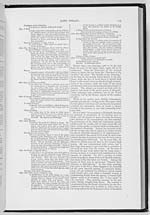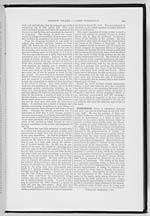244
country; but death made the purpose unavailing.
Such, however, even in its unfinished state, are the
remarkable qualities of the picture, that the Royal
Association accepted it at the price for which they
had stipulated when finished, and it now adorns the
National Gallery in Edinburgh. In the same collec-
tion is a reduced copy by Phillip of the celebrated
picture by Velasquez of the " Surrender of Breda,"
in the museum at Madrid, generally called "Las
Lanzas," from the spears or pikes of the soldiers in
line, in the middle distance.
To this general sketch only a few particulars need
to be added. Besides being a member of the Royal
Academy, Phillip was an honorary member of the
Royal Scottish Academy, an institution in which he
took a warm interest, and during the last twelve
years he annually enriched its exhibitions by several
important works of his own which were among the
chief attractions of the collection. These pictures
had previously been exhibited in London, and were
obtained in loan from their owners.
Although half a Spaniard in the choice of his line
of art, and half a Londoner by long residence in the
British capital, his heart never ceased to beat affec-
tionately towards Scotland; he was well-known in
Edinburgh, where his almost unbroken annual visits
created a stir of satisfaction; and one of the chief
objects of his ambition was to obtain a habitation
and resting-place upon his native soil, in which he
succeeded a few years before he died by the pur-
chase of a cottage or shooting-box in Glen Ur-
quhart. It was at Divach, a picturesque spot at the
head of the glen; and in this Highland abode, he
hoped not only to enjoy a healthful summer resid-
ence, but a permanent at last, when his toils were
exchanged for the enjoyment of a tranquil old age.
In the meantime he prosecuted his art so diligently
that his works continued steadily to improve in
excellence; and being still in little more than the
meridian of life�for he had not yet completed his
fiftieth year�his admirers reasonably anticipated
such success from his matured powers as would ex-
ceed his past performances, distinguished though they
had been. An attack of low fever however, from
which he recovered, was succeeded on Tuesday the
19th of February, 1867, while conversing with a
brother artist, by a stroke of paralysis, from the effects
of which he died on the 27th of the same month.
The unexpectedness of such an event deepened the
sorrow of his friends and the public at large, who
hoped that he would be continued to them many
years longer, and that he would yet attain still
higher excellence. Thus passed away our modem
Velasquez�an artist who had won for himself the
reputation of being perhaps the first colourist not
only in Britain, but in Europe. The chief techni-
cal characteristics of his style may be said to be great
breadth of treatment and powerful colour. "He
threw his whole soul into his subject, seizing with
the instinct of genius its main points and effects, and
he worked with a zeal and enthusiasm which often
overtasked his physical powers. The result of his
Spanish experience, however, was only a splendid
development, or gorgeous blossoming, of his genius.
He was the same painter, as he was the same man
throughout, only growing greater in his art, and
dearer to his friends, year by year. His vigorous
and characteristic delineations of the manners and
customs of the Andalusians�in number almost
numberless, and infinite in variety; some simply
descriptive, some humorous, some full of passion or
of pathos�excited universal admiration in the world
of art�admiration warmly shared by his brother
artists, who acknowledged him with one voice as at
the very head of his profession in his own style. And
on art he has undoubtedly left his mark more dis-
tinctly and emphatically than any of his contem-
poraries can hope to do."
His personal character is thus given by one who
knew him intimately and enjoyed his friendship :�
"Manliness, honesty, perseverance, fortitude, and
geniality were the chief traits of Phillip's character
as a man. He was alike beloved and respected by
all who knew him, and throughout a life chastened
by severe trial and affliction, conducted himself at all
times so as to enhance the love and esteem of those
who knew him best. The suffering and depression
he occasionally endured never disabled him from
rejoicing with those that rejoiced: in his many trials
he always found solace in the society of his friends,
or in devotion to his much-loved art. Artists en-
dowed with faculties such as John Phillip possessed
are of rare occurrence, and are never repeated. We
have had greater artists, and we hope to have greater
still. His genius was only exceeded by his industry;
his art was only exceeded by his lovable qualities as
a man, and his complete sinking of self and selfish-
ness in all that he said or did."
When he died, the artist left behind him a widow
and two children, the elder a daughter approaching
maturity, and the younger a son about ten years of
age.
PICKEN, ANDREW. This amiable and agreeable
writer in miscellaneous literature was born at Paisley,
in 1788. His father, who was a wealthy and thriving
manufacturer of the town of Paisley, intended that
his son Andrew should follow the mercantile pro-
fession, and to that effect the youth was educated.
While still very young, he repaired to the West
Indies, but finding, on close trial, that the office he
held offered few of those advantages it had promised,
he returned home, and obtained a confidential situa-
tion in the Bank of Ireland. Here he might have
enjoyed years of tranquil comfort, and retired at last
with a competence, if he could have contented himself
with the monotonous routine of a banking establish-
ment; but having either too much genius, or too little
firmness and self-denial, for such a life, he threw up
his charge, to the great regret of his friends in Ireland;
returned to Scotland, and commenced business in
Glasgow on his own account. But, unluckily for his
interests, the same restless and aspiring spirit con-
tinued to haunt him; and finding the occupations of
the counting-house insufficient, he combined them
with the more attractive and congenial pursuits of
authorship. We can easily guess how such a mer-
chant would be regarded in those days by his brethren
of the Tontine, and what faith they would attach to
bills subscribed by the same hand that wrote stories
and novels. In the meantime, his first work came
out, under the title of Tales and Sketches of the West
of Scotland; and, independently of the novelty of such
a rara avis as a Glasgow litterateur, the intrinsic
merits of the work itself secured for it a large share
of local popularity. Among these tales, that of
"Mary Ogilvie" is an admirable specimen of his
dramatic power in investing ordinary events with
high interest, and giving them unwonted influence
over our best feelings. As an offset, however, to
this, one of the sketches produced a very opposite
effect; it was "On the Changes of the West of Scot-
land during the Last Half-century;" and every one
aware of these changes can easily divine how hard
his notices must have occasionally borne upon some
of the most influential and worshipful of the rising
city of Glasgow. These notices Mr. Picken did not
withhold; on the contrary, he revelled among them

![]() Universal Viewer |
Universal Viewer | ![]() Mirador |
Large image | Transcription
Mirador |
Large image | Transcription
![]()

